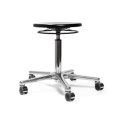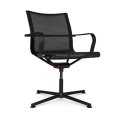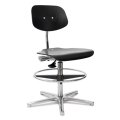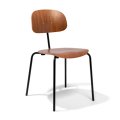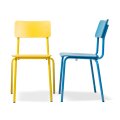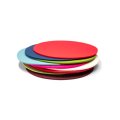Office chair - find a model that suits you
Office chairs are specially designed for working at a desk. As rolling swivel chairs, they offer you a practical range of movement. So far, so good. But why is it that not all office chairs are the same and how can you find a model on which you can sit and work in a relaxed manner?
Important criteria for choosing your office chair
Take a seat? Gladly! Or don't you? In order to find an office chair that offers you the support you need over several hours, it is advisable to think about a few things in advance:
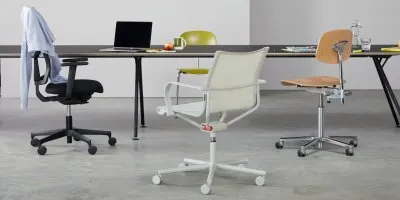
- The length of time you sit: Are you looking for a chair to work occasionally in your home office? Or do you plan to spend the majority of your daily working time on a desk chair?
- Your height: Do you measure 155 or 195 cm? Even though the seat of an office chair is usually height-adjustable between about 42 and 55 cm, you should make sure that you can adjust the model to your individual height. For children, there are models specially adapted to their proportions, such as our Modulor children's chair with mesh backrest.
- Body weight: Most desk chairs are designed for users weighing up to 120 kg. If you weigh more, look for models with a corresponding load capacity.
- Your personal sitting habits: Are you one of those people who rarely sit on their office chair at their desk for more than half an hour at a time before they feel the urge to do some standing work? Or do you forget the time while you concentrate on your work and don't even notice how you slowly slide deeper and deeper into the cushions of your office chair?
- Your individual requirements and ideas: Have you possibly already had a slipped disc and need special support in the area of the lumbar or cervical spine? Should the chair correspond to a certain style of furnishing or is it important to you what materials the upholstery and covers are made of? Would you like to buy a comfortable executive chair or would you prefer a simple work chair like our Modulor model?
Keyword desk sharing: If you do not use the office chair exclusively yourself, but share your workplace with colleagues, also take their interests into account when planning.
Sit down, please! But how?
The ideal working posture is one thing, but the fact that the muscles tire when we sit for long periods of time and that we don't sit quite as upright at the end of the working day as we did in the morning is another. An ergonomic office chair can help you maintain your posture over a longer period of time. Two things are particularly important in this context:

The ergonomic sitting position
Your sitting position at your desk is ergonomic if you are in an upright position and your spine is in its natural S-shape. The pelvis is tilted slightly forward. The head is in a straight position with the chin slightly lowered. The feet are about hip-width apart and firmly planted on the floor. The upper and lower arms and the upper and lower legs are at about a 90° angle to each other. The arms rest relaxed on the armrests of the office chair or the top of the desk.

Dynamic sitting
You sit dynamically if you change your sitting position on the desk chair as often as possible. The changes in posture relax and activate the muscles. This prevents tension, improves blood circulation and thus leads to a better oxygen supply. Your intervertebral disc is also better supplied with nutrients through the movements.
Tip: No matter how dynamically you sit, it can be useful to consider the 2/3-1/3 rule for a balanced load: A 40-minute sitting phase should be followed by 20 minutes of standing. If you combine your ergonomic office chair with a height-adjustable desk, you are prepared for anything.
The anatomy of the desk chair
Whether swivel chair, executive chair or children's desk chair - basically almost all office chair variants are made up of the following elements:

The backrest
It should support and stabilise the back and at the same time allow it to move. Ideally, upholstered versions are based on the shape of the back and have an adjustable curve in the area of the lumbar vertebrae - the so-called lumbar support. If your office chair has an automatic seat, you enjoy additional comfort. In this case, the counterpressure in the area of the back regulates itself automatically and adjusts to your weight. As a result, a lighter person does not need to exert more force than a heavier person to lean back.
Ideally, the backrest of the office chair should also be adjustable in height and depth for individual adjustment. A headrest can support relaxed sitting.
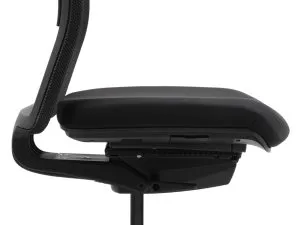
The seat
It is usually a flat or trough seat, the height of which can be continuously adjusted by means of a gas pressure spring. If the seat depth and tilt angle can also be adjusted, your office chair will help you find an ergonomic sitting position. Models with an integrated automatic seat tilt adjustment go one step further. They ensure that the seat of the desk chair also tilts forward when you make a corresponding movement. This keeps your pelvis in the desired position and reduces the strain on your thighs.
Interesting: Some models, such as our Wagner D1 office swivel chair or the Glyph office chair, use a seat shell that combines the back section and seat surface into one unit.
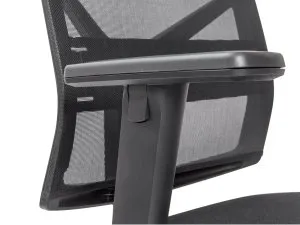
The armrests
They support the arms and relieve the shoulders to prevent tension. They are also useful when sitting down and standing up. In the best case, they are not only adjustable in height for individual adjustment, but can also be turned inwards and outwards.
Does your job require you to be able to stand up quickly and unhindered? In this case, an office chair without armrests may be the better choice.
Would you like to remain flexible? Our Modulor office chair and the Wagner D1 office swivel chair can be used with or without armrests.
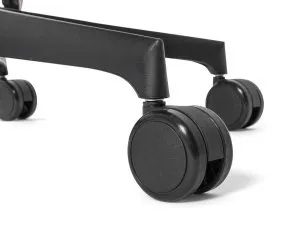
The base with castors or glides
The usually five-armed base provides a stable stand for the office chair. It is optionally available with castors or glides.
If extra mobility is required, castors are the right choice. They are available for hard and soft floors. Generally speaking, soft castors are suitable for hard surfaces such as parquet, PVC, laminate and tiles. Their rubberised surface ensures reduced abrasion, less noise and a plus in safety, as the office chair does not roll away so easily unintentionally. If your office is carpeted, on the other hand, hard office chair castors are called for. They keep the resistance low so that you can move your desk chair more easily. To make it easy to distinguish between the two types, hard castors are usually one-coloured, soft castors two-coloured.
As so-called castor castors, they always turn by themselves in the direction in which you move the chair. As a braked version, they ensure that the unused desk chair does not roll away on its own or while you want to sit down.
If you plan to use your office chair as a conference chair, glides may be the better choice for you. With them, your swivel chair is always firmly in place and can only be moved around by you.
Separately available accessories for Modulor chairs allow you to switch between castors and glides. Separate castors can also be added to the Wagner D1 office swivel chair.
Practical tip: When buying a new office chair, it is worth choosing a model with a modular system. If you can replace the individual elements independently of each other, as in the case of our Modulor office swivel chair, this offers you a particularly long service life. The Modulor student swivel chair is also based on the same principle.
Mechanics - the superpower of the office chair
Watch out, now it's getting technical. Perhaps you have already heard of terms like synchronous or 360° mechanism in your search for an ergonomic office chair. We explain what is behind these terms. Generally speaking, the mechanics of a desk chair coordinate the movements of the individual chair components and at the same time determine your movement options.

The permanent contact mechanism
The permanent contact mechanism, for example, is an asynchronous mechanism. It is characterised by the fact that the backrest follows your every movement while the seat is fixed.
The rocker mechanism
The rocker mechanism, on the other hand, couples the movement of the back with the movement of the seat. The angle between these two office chair elements always remains the same. As a result, the movement of your upper and lower body is restricted. As this can lead to tension and prevent optimal blood circulation, a desk chair with a tilting mechanism is not necessarily the first choice if you plan to spend long days at your desk.
The synchronous mechanism
The synchronous mechanism (point synchronous mechanism) is different. Here, the backrest and the seat of the office chair are flexibly connected and move in a certain relationship to each other. If you lean back and the backrest tilts by 15°, for example, the seat follows with a 5° tilt if the ratio is 3:1. This offers you good conditions for dynamic sitting. If you move your upper body backwards on your office chair, the opening angle in the pelvic area increases while your feet remain in contact with the floor.
The 3D mechanism
If you prefer maximum mobility, a 3D mechanism (often referred to as a 360° mechanism) such as the patented Dondola® seat joint from Wagner is a good option. Located between the seat shell and the chair base, it allows you to make gentle micro-movements the entire time. The alternation between tension and relaxation relieves your spine and strengthens the muscles. For an excursion into the fourth dimension, the Wagner D1 office swivel chair offers you two additional joint axes. These make the opening angle between the upper and lower body variable.
If you would like to learn more about the motion-friendly Wagner office chairs, you can find out more on our brand page.
And now for the big question: How do I adjust my office chair correctly?
You have already learned about the ergonomic sitting position and the individual elements and capabilities of your office chair, now comes the next step: personalise your model!

Start with the seat. Bring it to a height where your thighs rest about 2/3 of the way up, 3 to 4 fingers fit between the edge of the seat and your calf and your feet are firmly on the floor. Adjust the seat depth of the swivel chair until your pelvis is in contact with the backrest. The seat angle should slope slightly forward so that your pelvis is upright.
Next, adjust the backrest to your anatomy so that the strongest curve is at the upper edge of the pelvis, the iliac crest. This allows your spine to maintain its natural S-shape and puts you in an upright position that puts less pressure on your intervertebral discs. If your office chair has a headrest, note that your head should neither fall back nor be pushed forward. Then adjust the mechanism and the counterpressure of the back section to suit you and finally bring the armrests into position. They should be level with your tabletop.
Important: Even with an ergonomic office chair you do not automatically sit correctly. Therefore, also take a look at your desk and your computer screen and check to what extent they support a healthy posture.
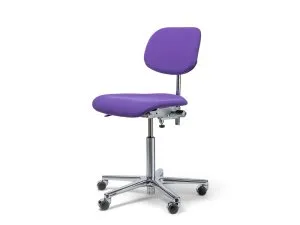
Office chair: design, colour and material
The undisputed number one office chair colour is ... quite clearly: black! Classic, simple and unobtrusive, a black desk chair blends harmoniously into any office interior. But fresh colours don't just look good on a child's desk chair. Make use of the effect of the different colours and deliberately set accents. Who knows, maybe after just a few weeks you will notice the stimulating effect of a red Wagner Office stretching chair W-ork low and the mood-lifting effect of a yellow office chair Glyph.
Decide freely according to your taste. A rule that can also be applied to the materials of your office chair. Does the lacquered beech plywood of our Modulor office swivel chair appeal to you? Are you looking for an airy and breathable version with a mesh covering in the back like our in-house office chair? Or do you prefer a model with soft upholstery like the CETO® from Steifensand?
In addition to wood, leather and imitation leather, the desk chair range is dominated by textile covers. They are based on both synthetic and natural fibres. Whether you prefer hard-wearing polyamide, dimensionally stable polyester or blends with a proportion of temperature-regulating wool is up to you. In any case, we recommend that you consider aspects such as abrasion resistance, flammability, breathability and the care properties of the different materials when deciding on a particular cover.

Keep it clean! Cleaning and care of your swivel chair
In order to enjoy your office chair for as long as possible, you will have to invest a little time in cleaning and caring for it from time to time. The most important rule is always: consult the instructions on your office chair!
You can easily remove crumbs, lint and other particles that settle in textiles and upholstery with a hoover. Work with reduced suction power so as not to place too much strain on the materials.
When removing dirt, it is not only the material of your office chair cover but also the stain that determines the chosen remedy. You can treat organic stains with water and a little dishwashing liquid. Stains that are not water-soluble may require tougher measures. In general, it is good to tackle stains promptly to prevent the dirt from settling into the fibres. Always work from the outside in to prevent the stain from spreading further and, if in doubt, call in a specialist.
Office chair care is generally more complicated if you have a leather executive chair. Although leather is hard-wearing and durable, it is also sensitive to light and dry air. Leather grease can help here. Dust can simply be wiped off with a damp cloth. Stains on your leather office chair, on the other hand, should be left to a professional.
An office chair rarely comes alone
Office chairs are all well and good, but do you also know about our work stools? They complement your office equipment in a compact format and provide variety in your everyday sitting. Since the models usually have no backrest, they offer you unrestricted freedom of movement in your upper body and challenge your muscles. Take a closer look at our rolling, stacking and standing stools and find the right sidekick for your desk chair.
